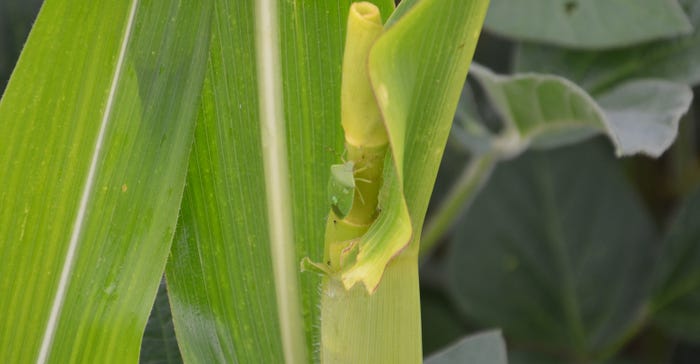
Volunteer corn emerges early in the season with your soybeans. When you’re deciding whether to add a herbicide to take it out on your postemergence pass, there are stalks here and there. You decide to save the money. Did you make the right choice?
If you think that’s the right choice, look at the picture of Steve Gauck holding two soybean plants. The plant on the left was growing near volunteer corn. The plant on the right was an average plant growing with no volunteer corn nearby.
Related: How dense is your soybean factory?
“The difference was striking and speaks for itself,” says Gauck, Greensburg, Ind., a regional agronomy manager for Beck’s, sponsor of Soybean Watch ’22. “Plants competing with volunteer corn grow straight up, seeking sunlight.
“This plant had only four nodes for pods, with large distances between nodes. There were no branches. The other plant had branches, and nodes were much closer together.”
What makes it a judgement call, of course, is that most plants within the field weren’t growing near volunteer corn plants. Even when there is enough volunteer corn to make the field unsightly, it’s difficult to determine if what you’re losing in bushels per acre would pay for the extra herbicide.
“That applies in this case because volunteer corn was scattered,” Gauck says. “There are fields where enough volunteer corn emerges to make it an easy call. The problem at this time of year is that it is too late to do anything about it. You needed to make the call earlier.”
Other factors
Even in a field where volunteer corn is scattered, Gauck would opt for taking it out. “Volunteer corn in the field can attract insects,” he explains. “We found a green stinkbug on a corn plant where I pulled the soybean plant. You don’t want to invite stinkbugs into your soybean field.”
The corn hybrids many people plant today have Bt traits for corn borer, corn rootworm and/or glyphosate and Liberty tolerance. Odds are that if the hybrid had a trait, volunteer corn plants will also. While there’s no solid proof, entomologists speculate that allowing volunteer plants with insect traits to grow could impact insect resistance issues down the road.

“My preference is taking it out, even if volunteer corn is just scattered,” Gauck says. “It’s something you must be prepared to do when volunteer corn is small.”
Maximum labeled heights for control of volunteer corn plants range from about 5 to 12 inches tall, depending on the product.
Unless you’re growing non-GMO corn, Gauck advises against counting on glyphosate or Liberty to control volunteer corn. The easiest solution is adding a herbicide containing clethodim to your early postemergence soybean mix. Clethodim is very effective against volunteer corn, he concludes.
About the Author(s)
You May Also Like




